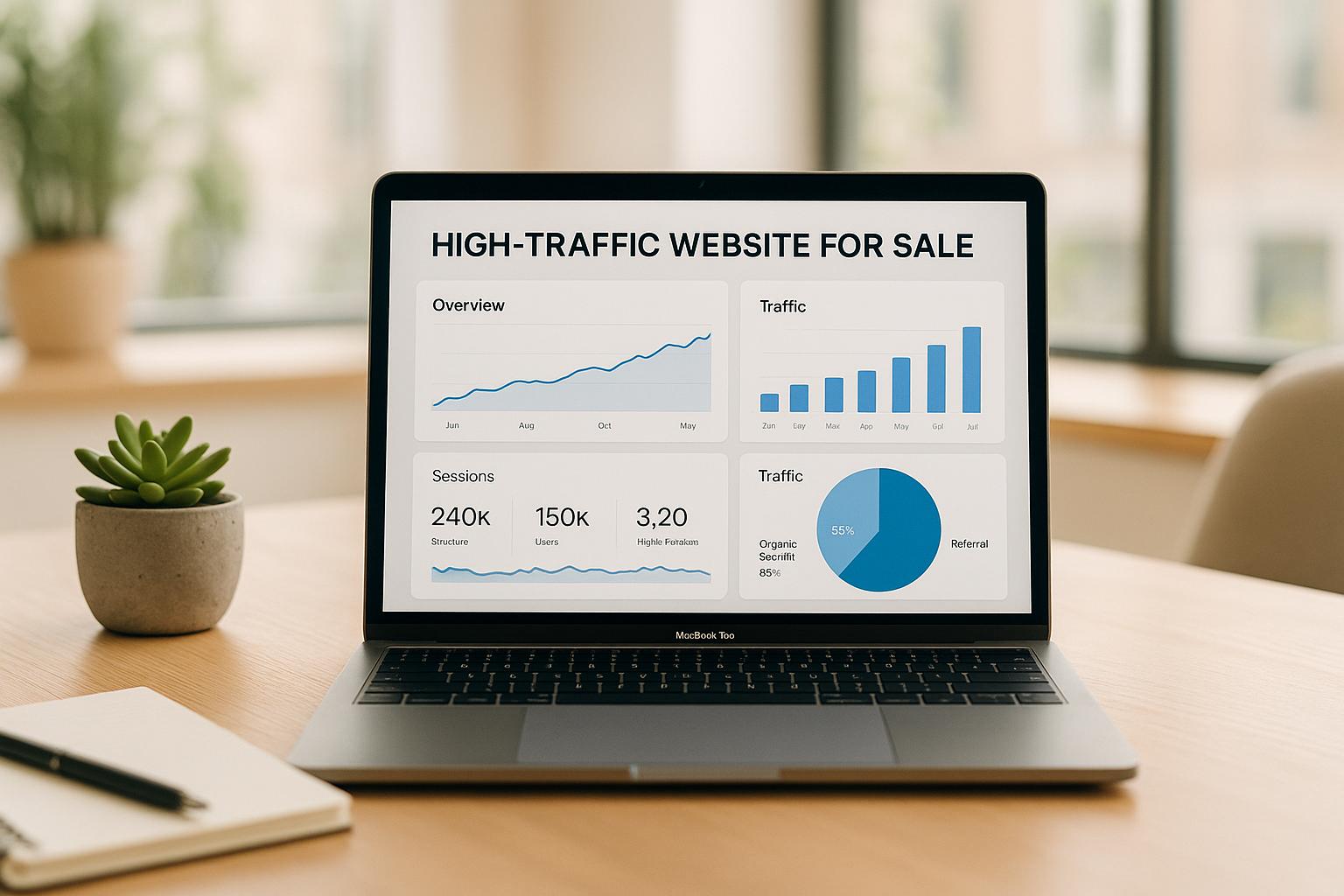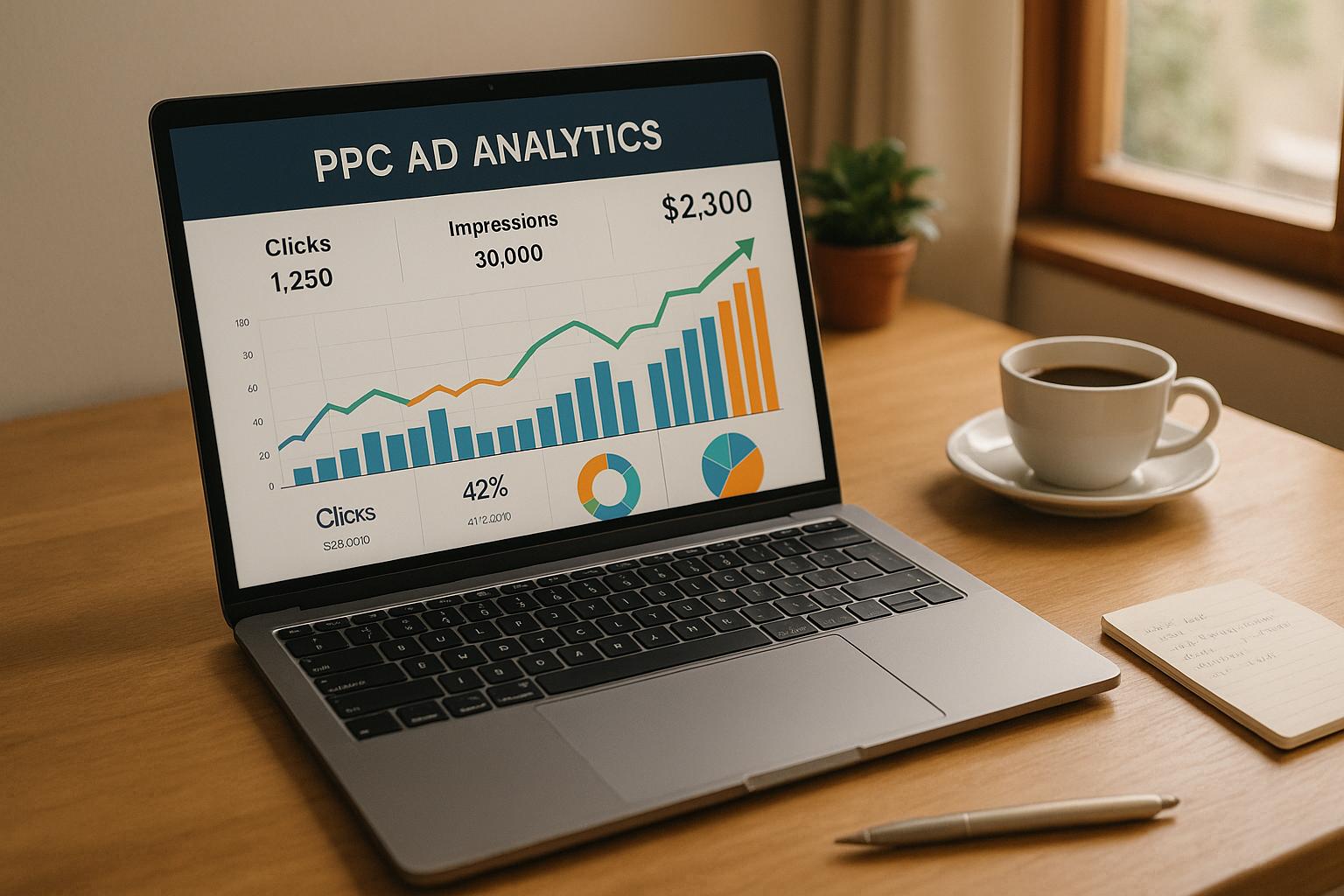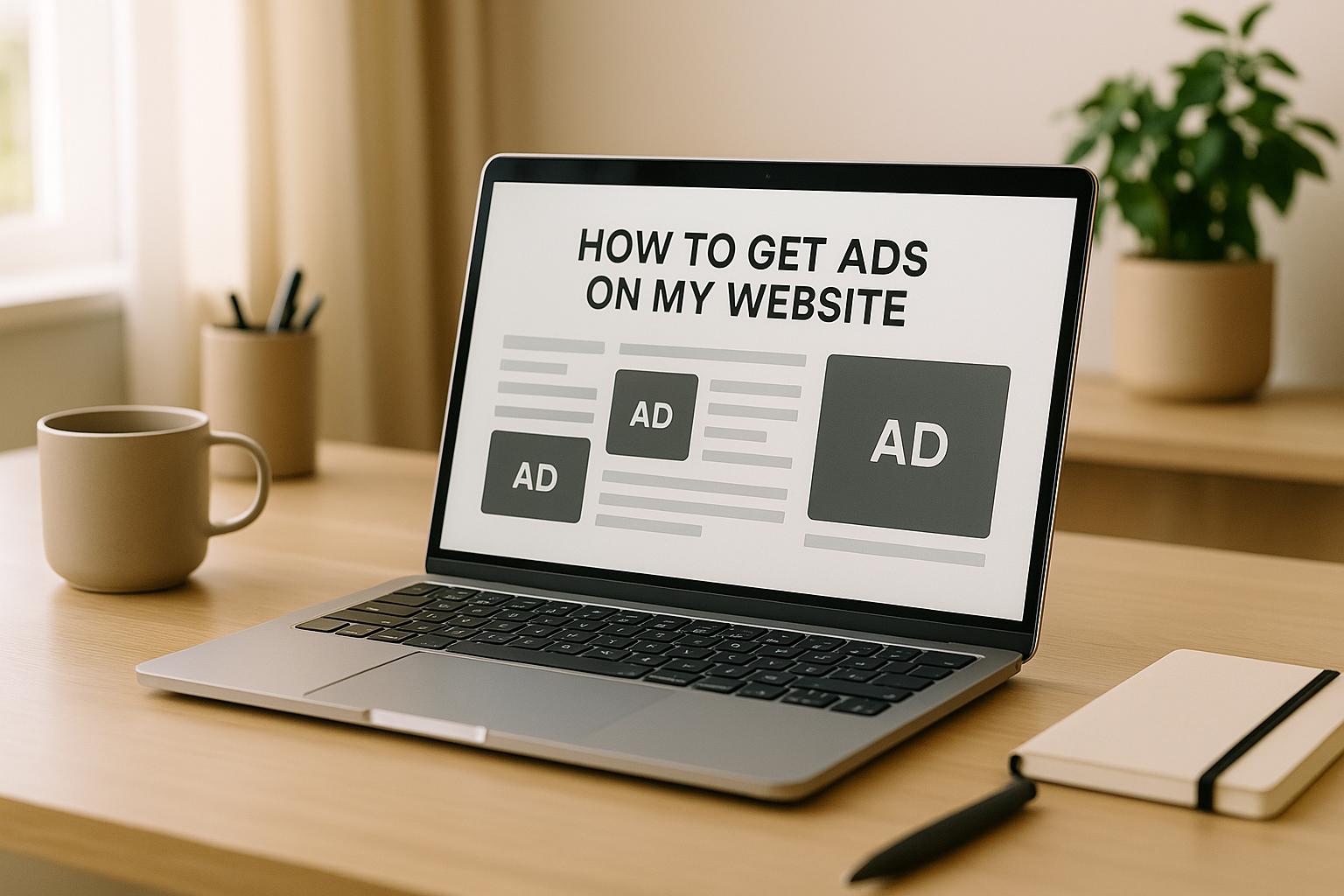Buying organic traffic can help publishers grow their audience and boost revenue, but it comes with risks. Here’s what you need to know:
- What is organic traffic? Visitors who land on your site through unpaid search results, driven by genuine interest in your content.
- Why it matters: Organic traffic drives 53% of website visits and has a higher conversion rate (2.4%) compared to paid traffic (1.3%).
- Benefits: Increased visibility, better ad revenue, stronger SEO, cost-effectiveness, and long-term credibility.
- Risks: Fake traffic, distorted analytics, search engine penalties, financial losses, and legal issues.
- How to stay safe: Use trusted providers, verify traffic quality with tools like GA4 and SEMrush, and watch for red flags like sudden traffic spikes or low engagement.
Bottom line: Buying organic traffic can work if you focus on quality and transparency. Pair it with solid SEO and content strategies for sustainable growth.
What Is Organic Traffic and Why It Matters
What Is Organic Traffic?
Organic traffic refers to the visitors who land on your website through unpaid search engine results. This includes visits stemming from search engine referrals, external links, direct visits, and even social signals. What sets organic traffic apart from paid traffic is that these visitors arrive because they’re genuinely interested in your content, not because of a paid ad. Here’s a compelling stat: organic traffic boasts a conversion rate of 2.4%, compared to just 1.3% for paid traffic.
Think of it as a natural digital endorsement. For instance, when someone searches for "best budget smartphones 2025", they’re likely to click on naturally ranked, relevant content. This organic process is what makes it so valuable for publishers aiming for long-term success.
Why Publishers Need Organic Traffic
For publishers, organic traffic isn’t just another metric - it’s the backbone of sustainable growth and monetization. Search engine optimization (SEO) drives more leads and offers a much better return on investment than paid efforts - 748% ROI compared to 36%. This is especially crucial for publishers working with tight budgets.
But it’s not just about numbers. Organic traffic also builds trust and credibility with your audience. When users discover your content through a natural search, they often view it as more reliable and authoritative than paid or sponsored material. This trust translates into higher engagement, longer time spent on your site, and greater loyalty.
The data speaks for itself: organic traffic accounts for 62% of website visits, while paid traffic contributes 21%, email and social media 13%, and other sources just 4%. These figures highlight the high intent and quality behind organic visits.
What’s more, well-optimized content can keep driving traffic over time without the need for constant ad spend. For niche publishers, this consistent visibility is vital for building authority in specialized areas. It can also open doors to opportunities like partnerships, speaking engagements, and premium monetization strategies.
AI Wars: How publishers can evolve their organic search strategy with Duncan Colman
Benefits and Risks of Buying Organic Traffic
Buying organic traffic can offer some exciting opportunities for growth, but it also comes with risks that publishers need to weigh carefully. Let’s break down the advantages and challenges of this approach.
Benefits of Buying Organic Traffic
One of the biggest perks of purchasing organic traffic is the boost in visibility and reach. It can help your website gain exposure beyond what regular SEO strategies might achieve on their own. This expanded audience creates more chances to engage visitors, drive conversions, and grow your brand - all without relying on traditional advertising methods.
Another benefit? Increased revenue potential. When your site attracts more organic traffic, it becomes more appealing to advertisers. This can lead to better ad rates and open doors to profitable partnerships.
Additionally, quality organic traffic can strengthen your SEO efforts. Engaged visitors who spend time on your site and interact with your content contribute to higher search engine rankings, creating a cycle where better rankings bring in even more visitors.
For publishers on a budget, buying organic traffic can be cost-effective. Unlike paid ads, which charge per click or impression, organic traffic doesn’t come with ongoing costs per visitor.
Finally, consistent organic traffic helps you build credibility and authority. Over time, this can establish your brand as a trusted source in your niche, which is especially valuable in today’s mobile-first world, where over half of web traffic comes from mobile devices.
Risks of Buying Organic Traffic
Despite the benefits, there are risks involved that could harm your business if not managed carefully. The most alarming issue is the possibility of fake traffic. Low-quality or fraudulent traffic can damage your search engine rankings and erode your website’s credibility.
Fake traffic also distorts analytics. It often results in high bounce rates, making it harder to understand your audience or make informed decisions about your content strategy.
Another major risk is penalties from search engines. Platforms like Google use advanced algorithms to identify fake traffic. Websites with poor engagement metrics, such as low dwell times, can face ranking penalties - or even get banned altogether. Tools like Google Analytics may not always catch sophisticated fake traffic, adding to the challenge of maintaining performance.
There’s also the potential for financial losses. Money spent on low-quality traffic could be better invested in strategies that drive genuine growth.
On top of that, legal consequences are a concern. If the traffic you purchase violates advertising platform rules or involves fraudulent practices, you could face legal issues.
Lastly, relying on fake traffic is unsustainable. It rarely contributes to meaningful growth and can ultimately hurt your online presence in the long run.
Benefits vs. Risks Comparison
| Benefits | Risks |
|---|---|
| Greater visibility and audience reach | Search engine penalties and ranking damage |
| Increased revenue potential from ad partnerships | Distorted analytics that hinder decision-making |
| Improved SEO through quality engagement | Financial losses from low-quality traffic |
| Cost-effective compared to paid ads | Legal risks in some cases |
| Builds long-term credibility and authority | Credibility damage due to high bounce rates |
| Supports sustainable growth | Short-term, unsustainable results |
The bottom line? Buying organic traffic can be a smart move if done right, but it’s not a shortcut to success. It works best as part of a diversified strategy that focuses on attracting genuine, engaged visitors. In fact, 53% of publishers believe diversifying traffic sources is the key to improving site performance. Up next, we’ll explore how to choose reliable sources and keep tabs on traffic quality to avoid the pitfalls.
sbb-itb-957fd63
How to Find and Check Reliable Traffic Sources
Protecting your website’s reputation and budget starts with carefully evaluating traffic providers. Below, we’ll explore how to select trustworthy sources, verify the quality of traffic, and spot warning signs that could indicate potential issues.
How to Choose Trusted Traffic Sources
When selecting traffic providers, transparency is key. Look for providers that clearly explain how they acquire traffic, share measurable performance data, and offer detailed reporting.
To ensure credibility, review testimonials, case studies, and online reviews. Trustworthy providers will have a track record of success backed by verifiable metrics that demonstrate results from past campaigns.
Another hallmark of a reliable provider is comprehensive reporting. High-quality platforms provide analytics dashboards that include detailed metrics like traffic sources, conversion rates, and user engagement. These dashboards should offer real-time access and regular updates.
For example, TinyAdz stands out by connecting advertisers with niche publishers while prioritizing transparent reporting. Their approach ensures that traffic is both authentic and aligned with specific audience needs.
When evaluating providers, don’t hesitate to ask in-depth questions about their traffic sources, quality control processes, and refund policies. Reputable providers will offer clear, detailed answers. On the other hand, vague or evasive responses should raise concerns.
Choosing dependable traffic sources ensures your investment supports genuine, sustainable audience growth.
Tools to Check Traffic Quality
After identifying potential providers, use analytics tools to verify the authenticity of their traffic. Tools like GA4 and Google Search Console are great for monitoring user engagement. Metrics like high bounce rates or very short session durations can be red flags indicating low-quality traffic.
Additionally, platforms like Ahrefs and SEMrush provide insights into search performance and keyword data. For example, SEMrush’s Organic Traffic Insights combines data from multiple sources, giving you a more detailed view of traffic quality.
Fraud detection tools such as Adscore and Protected Media’s Real-Time Traffic Verification (RTV) take this a step further. Adscore offers instant traffic analysis, filtering out fraudulent activity before it impacts your campaigns. As Olga Dashuk from Adscore explains:
"Real-time traffic analysis. Adscore solutions let us track the traffic instantly. Before it reaches you or, at least, before you receive the payout, we receive detailed reports, filter, and block fraudulent traffic."
Similarly, Protected Media’s RTV uses AI and machine learning to catch compliance violations in real time, helping maintain high traffic standards.
Also, keep an eye on your PPC reports. Unusually high click-through rates paired with low conversion rates may indicate bot activity rather than genuine human engagement.
Red Flags to Avoid Bad Traffic Providers
Certain warning signs can help you steer clear of unreliable traffic providers. Be cautious of the following:
- Unreasonably low prices: High-quality traffic requires an appropriate investment. Extremely cheap rates often come at the expense of quality.
- Sudden traffic spikes: Without a clear explanation, unexpected surges in traffic might suggest bot activity. Legitimate traffic tends to grow gradually over time.
- Poor engagement metrics: High bounce rates, short session durations, and low page views per visit are often signs of automated traffic.
- Unfamiliar traffic sources: Be wary of traffic from unknown domains, regions outside your target market, or a large volume of visits from single IP addresses. Reliable providers should be able to explain their sources and provide geographic breakdowns.
- Lack of detailed reporting: If a provider can’t supply transparent reports, it could indicate hidden issues.
- Consistent, unnatural traffic patterns: Traffic that doesn’t fluctuate naturally may be artificially generated.
Studies show that up to 20% of digital ad impressions are affected by fraud, with as many as 21% served on sites created solely for advertising. Google itself advises publishers to monitor their traffic sources closely:
"As a publisher, it's important to understand the drivers and sources of traffic to your website. In extreme cases, an egregious traffic source that generates invalid clicks on your ads may lead to your account being disabled."
To protect your campaigns, consider implementing IP exclusions to block suspicious addresses and use geotargeting to ensure your ads reach the right regions. Regularly auditing your traffic sources and analyzing patterns can help you catch issues early, preventing them from damaging your site’s performance.
Spotting these red flags is an essential step before diving into strategies for ensuring transparent traffic reporting.
Best Practices for Quality Traffic and Clear Reporting
Once you’ve pinpointed reliable traffic sources and flagged potential issues, the next step is maintaining that quality through solid tracking and transparent reporting. These practices not only ensure consistent traffic quality but also help you build trust with advertisers and strengthen partnerships.
Setting Up Traffic Tracking and Monitoring
A robust analytics setup is the backbone of effective traffic management. Tools like GA4 and Google Search Console are invaluable for tracking metrics and analyzing user behavior, conversion paths, and organic search performance. These insights are critical for understanding how users interact with your site and where improvements can be made.
For a deeper dive into your traffic ecosystem, consider integrating tools like SEMrush and Ahrefs. Combining free and paid resources gives you a more comprehensive view of your traffic sources and performance.
To stay ahead of any anomalies, set up custom dashboards and alerts that notify you when traffic patterns deviate from the norm. For example, you can create alerts for sudden spikes or drops in traffic, helping you quickly identify and address potential issues.
Focus on metrics that matter most to advertisers, such as time on page, scroll depth, pages per session, and conversion rates. Research from Google highlights the direct link between page speed and audience retention, especially for news sites. These metrics not only demonstrate the value of your traffic but also provide actionable insights for optimization.
Routine reviews of your analytics are essential to catch tracking errors, missing conversion goals, or data discrepancies. Automating your reporting process can save time and ensure stakeholders receive regular updates on key metrics without manual effort.
With a strong tracking system in place, the next step is to collaborate with verified platforms to further enhance traffic quality.
Working with Verified Platforms
Accurate tracking lays the groundwork for working with verified platforms, which offer transparency and real-time performance insights. Platforms like TinyAdz are great examples, connecting publishers with verified advertisers and maintaining rigorous reporting standards. Their live performance data and stringent quality controls help ensure traffic authenticity.
When choosing a platform, prioritize those that provide real-time dashboards. These dashboards should display traffic sources, user engagement metrics, and conversion data, enabling you to monitor campaigns and make adjustments on the fly.
Clear communication with platform representatives is another key element of managing traffic quality. Reputable platforms often assign dedicated account managers who can offer tailored advice and insights for optimizing your traffic. Look for platforms that openly share their traffic quality standards, fraud detection methods, and performance benchmarks to foster transparency and trust.
Aligning with verified platforms not only strengthens your traffic quality but also reinforces ethical practices in organic traffic acquisition. Flexible reporting options allow you to meet diverse advertiser needs, whether they’re focused on engagement rates, conversion tracking, or demographic insights. By investing in verified platforms, you can attract higher-quality traffic and build stronger, more reliable advertiser relationships.
Conclusion: Key Points for Publishers
To wrap things up, let’s highlight how publishers can achieve steady growth by focusing on organic traffic. Here's a key fact worth considering: 70% to 80% of users skip paid ads and go straight to organic search results. This makes organic traffic an incredibly powerful tool for building a loyal, engaged audience over time.
When done right, organic traffic doesn’t just bring in numbers - it delivers quality. This translates into longer session durations, better conversion rates, and metrics that advertisers love. Plus, it boosts engagement, ad revenue, and brand recognition. But with these perks come challenges. Publishers need to carefully vet traffic sources and keep a close eye on quality to avoid risks like fake traffic or poor engagement.
A smart approach involves using data to guide decisions. Set up robust analytics tools, track key metrics like time spent on your site and conversion rates, and run regular audits to ensure your traffic remains high-quality. Pairing purchased organic traffic with a solid SEO and content strategy is a winning combination for long-term success.
Platforms like TinyAdz can help publishers navigate this landscape with confidence. By offering transparency, verified traffic sources, and detailed reporting, these tools make it easier to attract the right audience. With tailored targeting and reliable tracking, publishers can avoid common pitfalls and build a genuinely engaged audience that delivers real, lasting value.
FAQs
How can publishers make sure the organic traffic they buy is real and high-quality?
To make sure the organic traffic you’re paying for is legitimate and worthwhile, start by tapping into reliable tools like Google Analytics or Google Search Console. These platforms can help you track where your traffic is coming from, how users are engaging with your site, and any noticeable patterns. Keep an eye out for steady, natural growth over time. Sudden, unexplained traffic spikes? They could be a red flag for fake traffic.
It’s also important to confirm that your traffic originates from trustworthy sources. For instance, traffic driven by search engines or relevant keywords is a good sign, whereas visits from unrelated or sketchy websites should raise concerns. Working with transparent providers who offer detailed reports about traffic origins is another way to dodge low-quality or fraudulent traffic. By staying alert and following these practices, you can ensure your traffic acquisition is ethical and delivers real value.
How can I tell if a traffic provider might not be trustworthy?
Keeping an eye out for unreliable traffic providers is essential to avoid squandering time and money on poor-quality or fake traffic. Some clear red flags include high bounce rates, brief session durations, and sudden traffic surges that fail to translate into meaningful engagement or conversions. Additionally, unusual patterns, like a wave of visitors from unexpected locations or devices, can signal trouble.
To make sure you're partnering with a dependable provider, dive into your analytics and watch for these warning signs. Trustworthy sources will always be upfront, offering detailed reports and metrics to confirm their traffic’s quality and authenticity.
What is the long-term impact of buying organic traffic on a website's SEO and credibility?
Buying organic traffic can positively influence your website’s SEO and reputation if approached the right way. It can increase your site's visibility, enhance search rankings, and draw in a broader audience - all of which signal relevance and authority to search engines.
That said, the key is to prioritize authentic, high-quality traffic. Fake or low-value traffic can backfire, damaging your site's reputation, eroding user trust, and ultimately hurting your SEO. By sticking to genuine traffic sources, you can cultivate trust, boost your site's authority, and set the stage for steady growth that supports both your credibility and overall performance over time.


